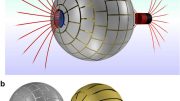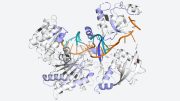
Cerebellums from Down syndrome-like mice treated with a new compound (left), untreated mice (middle), and normal mice (right). From I. Das, J.-M. Park, et al. Hedgehog Agonist Therapy Corrects Structural and Cognitive Deficits in a Down Syndrome Mouse Model. Sci. Transl. Med. 5, 201ra120 (2013). Reprinted with permission from AAAS. Credit: I. Das, J.-M. Park, et al.
In a newly published study, scientists detail the development of an experimental compound that reverses Down syndrome-like learning deficits in mice.
Researchers at Johns Hopkins and the National Institutes of Health have identified a compound that dramatically bolsters learning and memory when given to mice with a Down syndrome-like condition on the day of birth. As they report in the September 4 issue of Science Translational Medicine, the single-dose treatment appears to enable the cerebellum of the rodents’ brains to grow to a normal size.
The scientists caution that the use of the compound, a small molecule known as a sonic hedgehog pathway agonist, has not been proven safe to try in people with Down syndrome, but say their experiments hold promise for developing drugs like it.
“Most people with Down syndrome have a cerebellum that’s about 60 percent of the normal size,” says Roger Reeves, Ph.D., a professor in the McKusick-Nathans Institute of Genetic Medicine at the Johns Hopkins University School of Medicine. “We treated the Down syndrome-like mice with a compound we thought might normalize the cerebellum’s growth, and it worked beautifully. What we didn’t expect were the effects on learning and memory, which are generally controlled by the hippocampus, not the cerebellum.”
Reeves has devoted his career to studying Down syndrome, a condition that occurs when people have three, rather than the usual two, copies of chromosome 21. As a result of this “trisomy,” people with Down syndrome have extra copies of the more than 300 genes housed on that chromosome, which leads to intellectual disabilities, distinctive facial features, and sometimes heart problems and other health effects. Since the condition involves so many genes, developing treatments for it is a formidable challenge, Reeves says.
For the current experiments, Reeves and his colleagues used mice that were genetically engineered to have extra copies of about half of the genes found on human chromosome 21.
The mice have many characteristics similar to those of people with Down syndrome, including relatively small cerebellums and difficulty learning and remembering how to navigate through a familiar space. (In the case of the mice, this was tested by tracking how readily the animals located a platform while swimming in a so-called water maze.)
Based on previous experiments on how Down syndrome affects brain development, the researchers tried supercharging a biochemical chain of events known as the sonic hedgehog pathway that triggers growth and development. They used a compound — a sonic hedgehog pathway agonist — that could do just that.
The compound was injected into the Down syndrome-like mice just once, on the day of birth, while their cerebellums were still developing. “We were able to completely normalize growth of the cerebellum through adulthood with that single injection,” Reeves says.
But the research team went beyond measuring the cerebellums, looking for changes in behavior, too. “Making the animals, synthesizing the compound, and guessing the right dose were so difficult and time-consuming that we wanted to get as much data out of the experiment as we could,” Reeves says. The team tested the treated mice against untreated Down syndrome-like mice and normal mice in a variety of ways, and found that the treated mice did just as well as the normal ones on the water maze test.
Reeves says further research is needed to learn why exactly the treatment works, because their examination of certain cells in the hippocampus known to be involved in learning and affected by Down syndrome appeared unchanged by the sonic hedgehog agonist treatment. One idea is that the treatment improved learning by strengthening communication between the cerebellum and the hippocampus, he says.
As for the compound’s potential to become a human drug, the problem, Reeves says, is that altering an important biological chain of events like sonic hedgehog would likely have many unintended effects throughout the body, such as raising the risk of cancer by triggering inappropriate growth. But now that the team has seen the potential of this strategy, they will look for more targeted ways to safely harness the power of sonic hedgehog in the cerebellum. Even if his team succeeds in developing a clinically useful drug, however, Reeves cautions that it wouldn’t constitute a “cure” for the learning and memory-related effects of Down syndrome. “Down syndrome is very complex, and nobody thinks there’s going to be a silver bullet that normalizes cognition,” he says. “Multiple approaches will be needed.”
Other authors on the paper were Jung H. Shin of the National Institute on Alcohol Abuse and Alcoholism, and Ishita Das, Joo-Min Park, Soo Kyeong Jeon, Hernan Lorenzi, David J. Linden and Paul F. Worley, all of the Johns Hopkins University School of Medicine.
The study was funded by the Down Syndrome Research and Treatment Foundation, Research Down Syndrome, the National Institute of Child Health and Human Development (grant number R01 HD38384), the intramural programs of the National Institute on Alcohol Abuse and Alcoholism, the National Institute of Mental Health (grant number MH51106) and the National Institute of Neurological Disorders and Stroke (grant number R01 NS39156).
Reference: “Hedgehog Agonist Therapy Corrects Structural and Cognitive Deficits in a Down Syndrome Mouse Model” by Ishita Das, Joo-Min Park, Jung H. Shin, Soo Kyeong Jeon, Hernan Lorenzi, David J. Linden, Paul F. Worley and Roger H. Reeves, 4 September 2013, Science Translational Medicine.
DOI: 10.1126/scitranslmed.3005983









I am here and tell you some think for this game,such a wonderful and amazing simple mode game Gaps Solitaire game this is new card and latest new version online game.